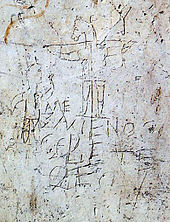Onolatry is the supposed worship of the donkey. In Imperial Rome, the charge of onolatry was used to taunt the Jews and Jewish Christians.[1] The association of Jews with donkeys was a common feature of Hellenic as well as Latin ethnographic and historical writings, and included accusations of worshipping a golden donkey head and even sacrificing foreigners to it at intervals.[2] A famous example of this is the Alexamenos graffito.[3]

The charge was likely first used against Jews in Egypt, where donkeys were at some points associated with Set, the murderer of Osiris who is in turn destroyed by Isis.[4] It is first attested in the late first century BCE, and was used against Christians extensively in the first and second centuries CE before disappearing almost entirely in the third.[5] The accusation against the Christians is discussed by Tertullian and Minucius Felix, among other early Christian apologists.[6]
Arthur Bernard Cook, in an 1894 article, argued that there had been an ancient Mycenaean cult practising onolatry, citing a fresco depicting donkey-headed figures found near a sacrificial pit and several carved gems apparently showing people wearing donkeys' heads and skins holding sacrificial objects, and further describing the diverse roles asses played in Ancient Greek mythology.[7] His interpretation was challenged at the time by Andrew Lang in Longman's Magazine.[8]
See also
editReferences
edit- ^ Gavrilyuk, Paul L. (2004). The Suffering of the Impassible God. Oxford University Press. p. 76. ISBN 978-0-19-926982-2. Retrieved 14 October 2008.
- ^ Wellman, T. J. (2008). "Making Tradition of an Ass. Zênôn the Alexandrian, a White Donkey, and Conversion to Hellenism". Religion and Theology. 15 (3): 321–339. doi:10.1163/157430108X376564.
- ^ Herbermann, Charles George (1907). The Catholic Encyclopedia. The Encyclopedia Press. p. 793. Retrieved 14 October 2008.
- ^ Cueva, E.P.; Byrne, S.N. (2014). A Companion to the Ancient Novel. Blackwell Companions to the Ancient World. Wiley. p. 183. ISBN 978-1-4443-3602-3. Retrieved 11 July 2018.
- ^ Ramelli, Ilaria (2013). "Apuleius and Christianity: The Novelist-Philosopher in front of a New Religion". In Pinheiro, M.P.F.; Bierl, A.; Beck, R. (eds.). Echoes of Myth, Religion and Ritual in the Ancient Novel. De Gruyter. p. 148. ISBN 978-3-11-031190-7.
- ^ Hassett, M. (1907). "The Ass (in Caricature of Christian Beliefs and Practices)". The Catholic Encyclopedia. Robert Appleton Company.
- ^ A.B. Cook (1894). "Animal Worship in the Mycenaean Age". The Journal of Hellenic Studies. 14: 81–169. doi:10.2307/623962. JSTOR 623962. S2CID 162848452.
- ^ "At the Sign of the Ship". Longman's Magazine. Vol. 24. 1894. p. 546. Retrieved 11 July 2018.
External links
edit- (in Italian) Tiberio..., of Zvi Yavetz, on books.google.it